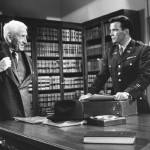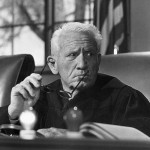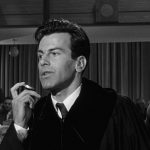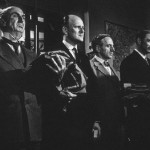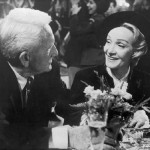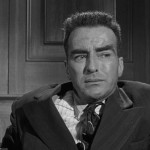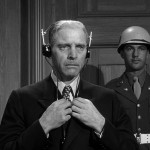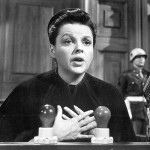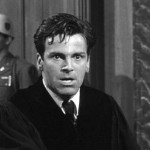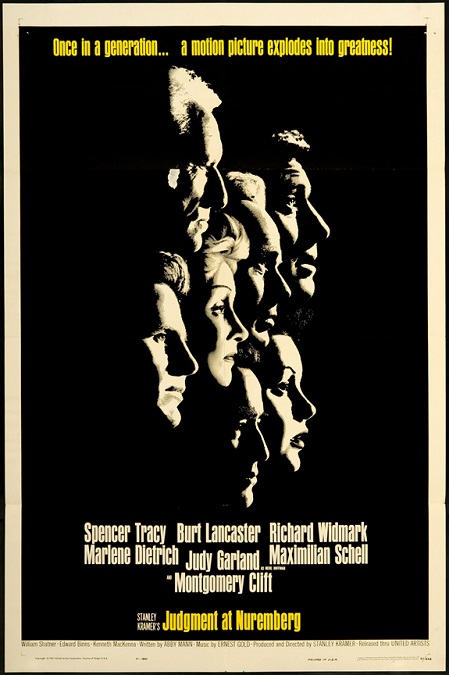
Judgment at Nuremberg – 1961
I think that any film that deals with the Holocaust in a factual and graphic way is a daring film. This one was even more so because it was the first main-stream motion picture to use actual footage that, even by today’s standards, was graphic and disturbing. It showed film footage of the rows and rows of dead bodies being disposed of after the end of WWII. Especially unnerving were the shots of corpses being shoveled into a mass grave by a bulldozer. Films like this are difficult to watch, but they are powerful. It is impossible to see those kind of images and not be affected. I can’t say I loved watching it, but it was certainly well-made and superbly acted. And just as a side note, I can’t help but think of what kind of emotional scars the driver of that bulldozer must have endured.
The film was a fictionalized account of one of the twelve U.S. military tribunals that took place in Nuremberg, and dealt with Nazi war crimes. This particular trial dealt with the non-combat crimes of four German judges, each of whom sentenced people, including women and children, to be moved to concentration camps, where death was a certainty. They also sentenced people to forced sexual sterilization in accordance with the Nuremberg laws. The four judges were Emil Hahn, played by Werner Klemperer, Werner Lampe, played by Torben Meyer, Friedrich Hofstetter, played by Martin Brandt, and Ernst Janning, wonderfully played by Bert Lancaster.
Lancaster, whose understated performance was a great contrast to his overacted performances in other Oscar nominated films I’ve seen, was just one of the huge names in this film. I read that many of the actors played their parts for significantly less money than they were used to because they believed in the importance of the subject matter. Spencer Tracy played the Chief Judge presiding over the trial, Judge Dan Haywood. A very young William Shatner played Captain Harrison Byers, Judge Haywood’s aid and acting bailiff of the trial. Richard Widmark played the passionate prosecuting attorney, Colonel Ted Lawson, while Maximillian Schell played Hans Rolfe, the equally passionate defense attorney.
Marlene Dietrich played Frau Bartholt, a widow who befriends Judge Haywood, offering a different perspective on the Holocaust from a German point of view. Montgomery Clift was incredible as Rudolph Peterson, a victim of sterilization and witness at the trial. Judy Garland was just as incredible, playing Irene Wallner, another witness, who had earlier been sentenced to prison for two years for crimes she did not commit, involving alleged sexual relations with an old Jewish man who had been her dear friend. Garland and Clift’s performances were remarkably powerful and realistic.
I was very impressed with the way the filmmakers handled the issue of the language barrier. The judges, attorneys, witnesses and defendants were all required to wear headphones throughout the entire trial, through which translators were shown doing their jobs. The film started out with the some actors speaking English, while others spoke German. Then, during Schell’s opening argument, delivered in German, the camera did a quick zoom to a close-up of his face, and he began speaking English. From then on, even though the headphones were never discarded, all the dialogue was delivered in English. Whenever a German character spoke without the translators, the point was made that the character knew how to speak English. I like that the filmmakers relied on the intelligence of the movie-going audiences to understand that distinction.
Another thing I liked was the ending of the film. One of the movie’s biggest themes, of course, was the guilt, of lack of guilt, of the defendants. Were they innocent of the charges being brought against them because they were just following orders, or did they have knowledge of the criminal nature of sentences that they delivered when they had been on the bench? Were they, in their capacity as judges, accomplices to the atrocities of the Holocaust?
In the final scene, after Judge Haywood has found all four of the defendants guilty and sentenced them to life in prison, Ernst Janning, asks to see Haywood alone in his prison cell. He says, “Judge Haywood… the reason I asked you to come: Those people, those millions of people… I never knew it would come to that. You must believe it. You must believe it!” To which Haywood replies, “Herr Janning, it ‘came to that’ the first time you sentenced a man to death you knew to be innocent.” That’s some great writing!
